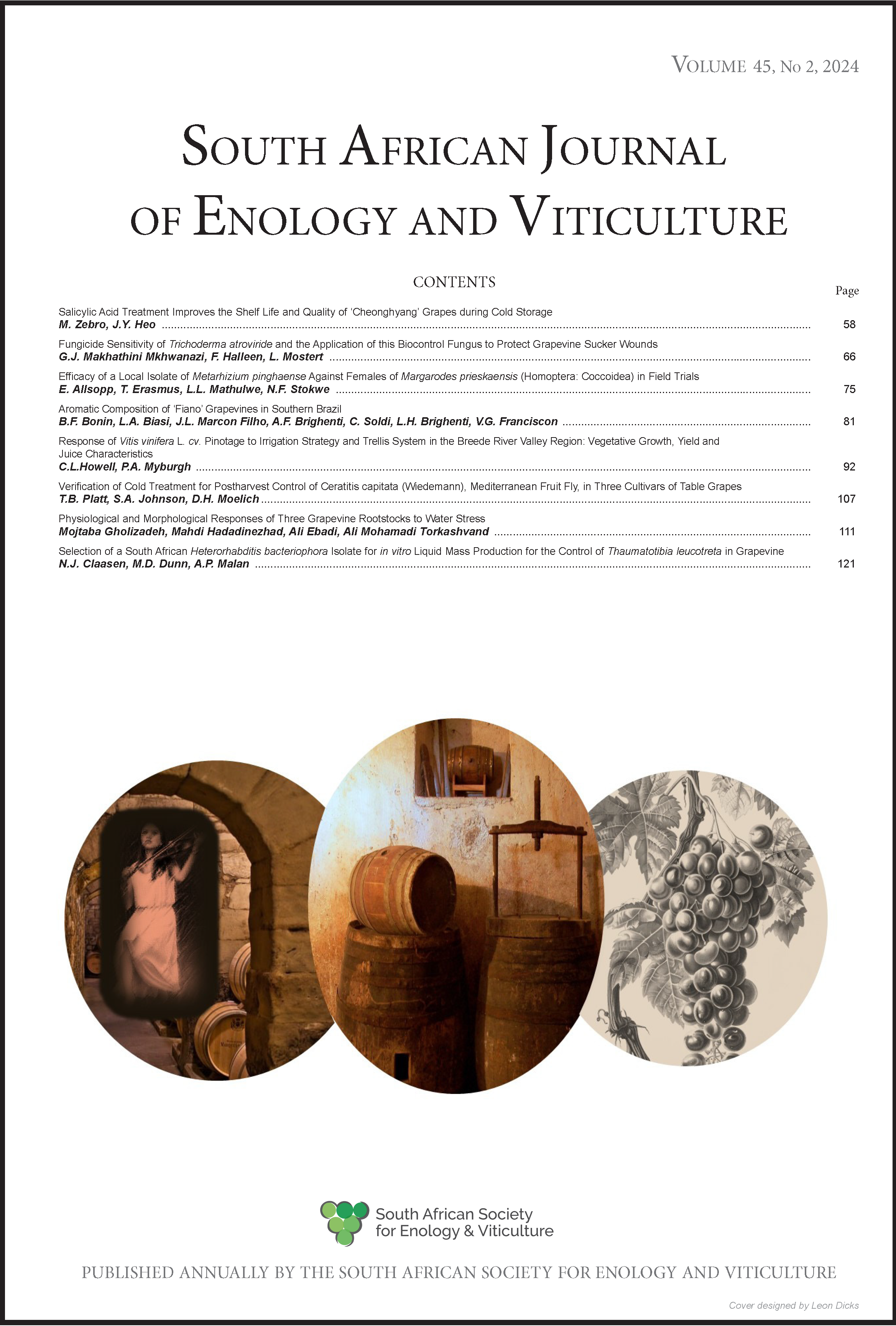Bud load and its influence on agronomic performance and wine aromatic composition of ‘Fiano’ grapevine in Southern Brazil
DOI:
https://doi.org/10.21548/45-2-6515Abstract
The objective of this study was to evaluate the influence of bud load on the agronomic performance and composition of volatile compounds of the ‘Fiano’ grapevine cultivated in Southern Brazil. The experiment was conducted in a commercial vineyard in the municipality of Campo Largo, Paraná (Southern Brazil) in the 2019/2020 and 2020/2021 seasons. Vines were Guyot-pruned and evaluated according to different bud loads: 10, 20, 30 and 40 buds per plant. Agronomic performance, technological maturity and the volatile compounds were evaluated, and the data were submitted for variance analysis. The mean values were compared using the Tukey test (p < 0.05). The volatile compounds in the wines were identified using gas chromatography (GC-MS/HS-SPME). The loads of 30 and 40 buds per plant showed an increase in productivity and the maintenance of the physical characteristics and technological ripeness of the grapes. A higher bud load resulted in a larger leaf area and better values for the Ravaz Index. However, the highest bud load (40 buds per plant) reduced the sprouting and shoot length, while a bud load of 30 buds per plant presented the best agronomic performance in the subtropical region of Southern Brazil. The physical characteristics of the bunches and the technological ripeness were not affected, and the increase in bud load did not alter most of the volatile compounds of ‘Fiano’ wines. However, some volatile compounds, such as diethyl succinate and linalool, presented higher concentrations in wines with the lowest yields (10 buds per plant).
Downloads
Downloads
Published
Issue
Section
License
A copyright form will be e-mailed to the corresponding author when the manuscript has been accepted for publication.
In principle, the Author agrees to the following when he/she signes the copyright agreement:
I hereby assign to the SOUTH AFRICAN SOCIETY FOR ENOLOGY AND VITICULTURE (SASEV) the copyright of the text, tables, figures, supplementary material, illustrations and other information (the Material) submitted with the manuscript to be published in SOUTH AFRICAN JOURNAL OF ENOLOGY AND VITICULTURE (SAJEV) (the "Article"). The copyright becomes effective from the date the Article has been accepted for publication in SAJEV.
This is an open access journal, and the authors and journal should be properly acknowledged, when works are cited.
Author's may use the publishers version for teaching purposes, in books, theses, dissertations, conferences and conference papers.
A copy of the authors' publishers version may also be hosted on the following websites:
- Non-commercial personal webpage or blog.
- Institutional webpage.
- Authors Institutional Repository.
The following notice should accompany such a posting on the website: This is an electronic version of an article published in SAJEV, Volume XXX, number XXX, pages XXX - XXX, DOI. Authors should also supply a hyperlink to the original paper or indicate where the original paper (www.journals.ac.za/index.php/sajev/) may be found.
Authors publishers version, affiliated with the Stellenbosch University will be automatically deposited in the University's Institutional Repository SUNScholar.
Articles as a whole, may not be re-published with another journal.
The following license applies:
Attribution CC BY-NC-ND 4.0

